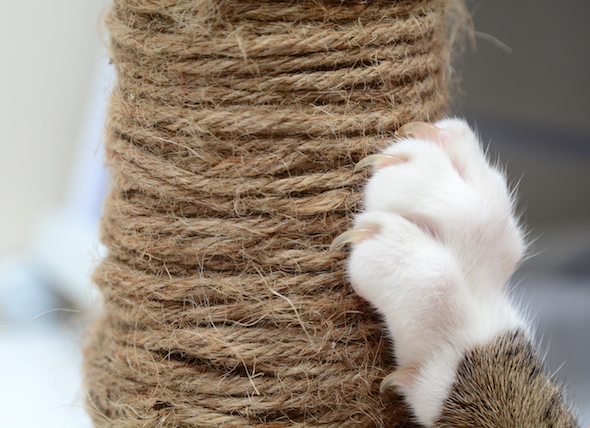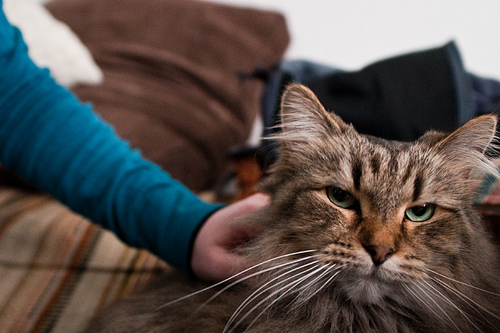

By Stacia Friedman
Though it might feel like it sometimes, your cat doesn’t scratch your furniture or carpets to upset you, she scratches to clean the exterior sheath of her nails, remove cuticles and to sharpen her claws—think of it as a feline manicure! While you can’t stop your cat from scratching, there’s a lot you can do to protect your furniture and redirect your cat’s behavior. Here are our top tips for keeping your cat from scratching your furniture.
When your cat digs her nails into your antique armoire, it’s easy to lose your temper and yell. That will only upset, confuse and provoke your cat. The best thing to do in these moments is to pick her up and place her next to a scratching post as a means of conditioning her.
Scratching posts provide cats with an outlet for their instinct to scratch while saving your furniture and carpets. “Choose a scratching post that is similar to the material your cat most likes to scratch,” said Meghan Herron, DVM and clinical assistant professor of behavioral medicine at Ohio State University.
Most cats prefer scratching posts made out of rough material they can shred. According to Herron, sisal (a coarse natural fiber) scratching posts are ideal because they are satisfying to scratch and tough enough to stand up to repeated use. Try a variety of scratching posts, like ones made from hemp, cedar, cardboard or rope, to find the one your cat prefers.
Cats that scratch chair legs or the corners of your couch may prefer a vertical scratching post, while cats that scratch rugs and carpets may prefer a horizontal scratching post or mat, Herron said, adding that vertical scratching posts should be tall enough so that your cat can stretch up to scratch. Scratching posts should also be stabilized to ensure that they don't move or tip over and scare your cat while she is using them.
“Cats scratch to leave scent marks that define their territory and tell other cats they have passed through. They will often scratch prominent objects near sleeping areas and room entrances,” Herron said. “Scratching posts should be located in these and other parts of the house. In multi-cat households there should be several scratching posts, both vertical and horizontal, located throughout the house.”
Here are a few training tips to get your cat used to scratching a post instead of your furniture:
Not all cats adapt to scratching posts. As an alternative, try covering her favorite scratching places with double-sided sticky tape like Sticky Paws. Cats’ paws are extremely sensitive. This acute sensitivity makes sticky surfaces exceptionally annoying, and cats will avoid scratching any place so uninviting.
Herbal sprays can also keep your cat from scratching unwanted areas of your home. “Don’t use anything that could harm the cat if she ingests it and be careful with strong odors because you don’t want the nearby acceptable objects to also smell unpleasant,” Herron cautioned.
Keeping your cat’s nails trim is another way to reduce damage from scratching. Herron recommends trimming the sharp tip of your cat’s claws about once a week, being careful not to cut into the quick (the pink portion of the nail), which will cause bleeding and be painful for the cat. Use a nail trimmer designed especially for cats, not for humans or dogs, and if you are unsure how to safely trim your cat’s nails, ask your veterinarian for a demonstration.
You can also dull your cat’s claws by sheathing them with Soft Paws, plastic caps which fit over your cat’s claws. Your cat will have to be patient enough to let you or a veterinarian put them on and trim the nails underneath, however. Some cats will take them off, but many tolerate them. They glue on easily, last four to six weeks and won't interfere with normal claw retraction.
Declawing, or the amputation of the end of a cat’s toes, is illegal in most cities in the United States and Canada. It is considered to be an act of cruelty and, if the cat goes outdoors, it cannot climb a tree and defend itself. It can also cause chronic pain. Many rescue shelters and cat adoption agencies have a “no declaw” clause in their contract. Before you consider this radical procedure, speak with your veterinarian about safer alternatives.
The sooner you provide your cat with appropriate scratching alternatives to your furniture and carpets, the happier you and your cat will be!
 The Best Way to Take Your Cat on Vacation With You
by Cheryl Lock
Vacation is supposed to
The Best Way to Take Your Cat on Vacation With You
by Cheryl Lock
Vacation is supposed to
 Cat Vet Visit Checklist
Because it is
Cat Vet Visit Checklist
Because it is
 Arthritis in Cats: Recognizing the Signs and Treating the Disease
By Ashley Gallagher, DVM
A
Arthritis in Cats: Recognizing the Signs and Treating the Disease
By Ashley Gallagher, DVM
A
 How to Introduce Cats
By Lynne Miller
If your cat used
How to Introduce Cats
By Lynne Miller
If your cat used
 Top 5 Tips for a Healthy Cat
Keeping your cat healthy, groomed, and wel
Top 5 Tips for a Healthy Cat
Keeping your cat healthy, groomed, and wel
Copyright © 2005-2016 Pet Information All Rights Reserved
Contact us: www162date@outlook.com